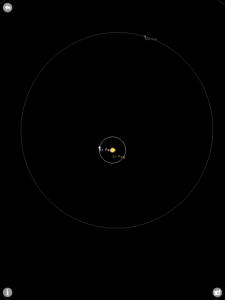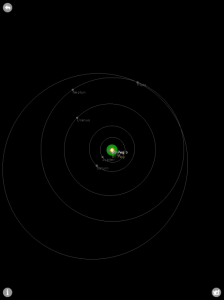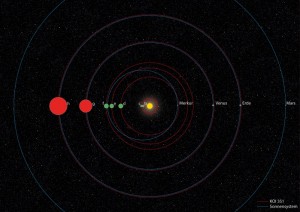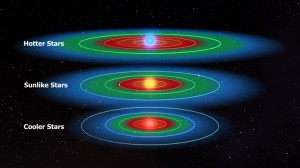Was sind Exoplaneten?
Seit der Entdeckung des ersten extrasolaren Planeten um 51 Pegasi (Mayor & Queloz, 1995) wurde die Suche nach extrasolaren Planeten enorm intensiviert und bis heute X Planeten entdeckt. Diese Planeten befinden sich alle in unserer Milchstraße. Abbildung 1 zeigt das Planetensystem 51 Pegasi im Vergleich zu unserem Sonnensystem. Zum Größenvergleich des Systems ist links die Bahn des Merkurs mit eingezeichnet und rechts die Bahnen aller Planeten in unserem Sonnensystem (einschließlich des Zwergplaneten Pluto).
Abbildung 1:


Welche Körper als extrasolare Planeten bezeichnet werden dürfen legte 2003 die IAU Working Group on Extrasolar Planets fest:
Körper mit einer wahren Masse unterhalb der Massengrenze für thermonukleare Fusion von Deuterium (< 13 Jupitermassen für Körper mit solarer Metallizität), die sich in einem Orbit um einen Stern oder um Überreste eines Sterns befinden (die Planetenentstehung spielt dabei keine Rolle) sind extrasolare Planeten. Die wiederum über Masse/Größe wie in unserem Sonnensystem definiert werden (Jupiter, Neptun, Erde).
Die Bezeichnung eines extrasolaren Planeten ist ebenso fest gelegt. Sie setzt sich aus dem Namen seines Zentralsterns und kleinen Buchstaben in alphabetischer Reihenfolge nach ihrer Entdeckung von innen nach außen zusammen (siehe Abbildung 2)
Abbildung 2:

Die bis heute entdeckten extrasolaren Planetensysteme zeigen ein weites Feld der Entwicklungszustände. Es gibt Planeten, die ihren Stern auf sehr nahen exzentrischen Orbits (e > 0,3) umkreisen (Zum Vergleich: die größten Exzentrizitäten in unserem Sonnensystem sind e = 0,2 für Merkur und Pluto). Andere extrasolare Planeten befinden sich auf Orbits, die wesentlich geringere Entfernungen von ihrem Stern haben, als der sonnennächste Planet Merkur (0,39 AU) in unserem Sonnensystem. Nicht nur die Orbits der extrasolaren Planeten weisen eine hohe Variabilität auf, auch unterscheiden sich die Planeten durch ihre innere Struktur und Zusammensetzung (Gesteinsplaneten, Gasriesen). Die Sterne selber zeigen ein ebenso breites Spektrum. Es gibt nicht nur Hauptreihensterne wie unsere Sonne, sondern auch massearme Sterne, Riesen, weiße Zwerge und Pulsare, die von planetaren Begleitern umkreist werden.
Leben wie wir es in Planetensystemen definieren, ist nur innerhalb der habitablen Zone möglich. Sie ist dadurch charakterisiert, dass in ihrem Bereich Wasser hauptsächlich in einem flüssigen Aggregatzustand vorliegt, welches als Voraussetzung für Leben gilt. Der Bereich der habitablen Zone ist von dem Sterntyp abhängig. In unserem Sonnensystem reicht die habitable Zone von der Marsbahn bis zum Orbit der Venus (0,95 – 1,37 AU, Kasting et al., 1993). Für heißere Sterne befindet sich die habitable Zone weiter entfernt vom Stern und für kühlere Sterne liegt sie näher am Stern (Abbildung 3).
Abbildung 3:
